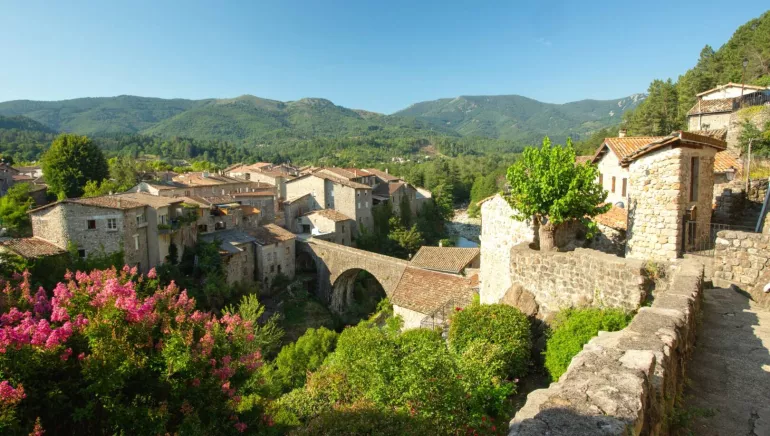Jaujac : village of character
Located at the edge of the Lignon river, at an altitude of 420 meters, the village has preserved and enhance a deep medieval character. This atmosphere is accentuated by paved streets, the castle of Castrevieille, the castle of Bruget. The central square lined with majestic plane trees distills a very southern atmosphere and comes alive regularly on market days.
This village is also a major site of Ardèche volcanism.
The village takes its name from the old seigniory of Jaujac, who lived in the 12th century and lived in the castle of Chastelas on the left bank of the river. Medieval village in the shape of a star, it revolves around a square planted with trees, adorned with a fountain. Its originality rests on its triad of castles: Castrevieille, Bruget, Rochemure.
A triad of castles.
There are three castles in the town.
The castle of Castrevieille, XIIIe, is located at the entrance of the village and belongs to the Count d'Antraïgues before becoming the property of the town. Imposing mass, it is characteristic of the bastides of the south of France: large main building flanked by towers giving it the appearance of a fort. It currently houses the village hall, as well as several rural houses.
The castle of Bruget, located on the road of Roudils, is the cradle of the old family of Bruget around the year 1378.The castle is worth the detour, it has beautiful coat of arms, a room with a magnificent French ceiling as well a winding staircase ending in an original palm vault.
Finally the castle Rochemure and his domain, located between the mouth of the volcano and the village, it was transformed to become the home of the Regional Natural Park of the Monts d'Ardèche.
Historic site steeped in history, the dungeon Chastelas, located in the old district of Jaujac, was built by De Jaujac, and razed in the fourteenth. It remains only the base of one of the walls in the district of Chastelas.
Nearby are many sights, such as the Jaujac Cup, remains of an ancient volcano. The "Roman" bridge of Chastelas which allows to cross a tributary of the Lignon going towards the spa of Neyrac-Les Bains.
The surroundings are ideal for observing the ancient basaltic flows that have given rise to magnificent octagonal prisms, which are called basaltic organs.
This village is also a major site of Ardèche volcanism.
The village takes its name from the old seigniory of Jaujac, who lived in the 12th century and lived in the castle of Chastelas on the left bank of the river. Medieval village in the shape of a star, it revolves around a square planted with trees, adorned with a fountain. Its originality rests on its triad of castles: Castrevieille, Bruget, Rochemure.
A triad of castles.
There are three castles in the town.
The castle of Castrevieille, XIIIe, is located at the entrance of the village and belongs to the Count d'Antraïgues before becoming the property of the town. Imposing mass, it is characteristic of the bastides of the south of France: large main building flanked by towers giving it the appearance of a fort. It currently houses the village hall, as well as several rural houses.
The castle of Bruget, located on the road of Roudils, is the cradle of the old family of Bruget around the year 1378.The castle is worth the detour, it has beautiful coat of arms, a room with a magnificent French ceiling as well a winding staircase ending in an original palm vault.
Finally the castle Rochemure and his domain, located between the mouth of the volcano and the village, it was transformed to become the home of the Regional Natural Park of the Monts d'Ardèche.
Historic site steeped in history, the dungeon Chastelas, located in the old district of Jaujac, was built by De Jaujac, and razed in the fourteenth. It remains only the base of one of the walls in the district of Chastelas.
Nearby are many sights, such as the Jaujac Cup, remains of an ancient volcano. The "Roman" bridge of Chastelas which allows to cross a tributary of the Lignon going towards the spa of Neyrac-Les Bains.
The surroundings are ideal for observing the ancient basaltic flows that have given rise to magnificent octagonal prisms, which are called basaltic organs.
Diese Einrichtung ist Accueil Vélo und bietet spezielle Dienstleistungen für Radfahrer an.
Contact par mail
* Pflichtfelder
Ein Problem mit dieser Einrichtung melden
* Pflichtfelder
